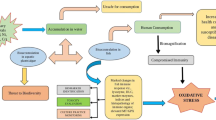Abstract
The exposure of blue gouramis to 9 ppb of methylmercury, copper, or methylmercury + copper resulted in an apparent decrease in the immune response of these fish to both infectious pancreatic necrosis (IPN) virus andProteus vulgaris. The two toxicants jointly, however, produced no greater or lesser effect than when each compound was applied singly.
In recent years much work has been concerned with the determination of various contaminants in the environment and in the establishment of the tolerance limits for these compounds. The heavy metals are some of the most toxic compounds to aquatic organisms, and of these, mercury and copper are among the most toxic. Recent studies (Roales and Perlmutter 1974) have established the median tolerance limit (Tlm) for methylmercury and copper to the blue gourami (Trichogaster trichopterus), and indicate that the two toxicants might interact antagonistically.
The immune response of fishes has been the subject of much study (Smithet al. 1966, Snieszko 1970). Recently, the immune response of the blue gourami to viral (Yuet al. 1969 and 1970, Perlmutteret al. 1973) and bacterial (Roales and Perlmutter 1975) antigens has been studied.
Mount (1968) determined that 3 to 7% of the 96-hr Tlm was the safe limit for fathead minnows exposed to copper. Rachlin and Perlmutter (1968) demonstrated that 10% of the 96-hr Tlm was the safest concentration for fathead minnows exposed to zinc. Although these levels are considered to be safe, it is possible that they are safe only so far as their toxicity or their effects on growth and reproduction are concerned. Quite possibly, safe doses of toxicants may affect fishes in less obvious manners.
Lead (Hemphillet al. 1971), cadmimum (Joneset al. 1971) and DDT (Wassermannet al. 1971) have been shown to reduce the immune response of mammals. Recent work (Sarot 1973) has shown that zinc decreases antibody production in the zebrafish.
Similar content being viewed by others
References
Baker, J.T.P.: Histological and electron microscopical observations on copper poisoning in the winter flounder (Pseudopleuronectes americanus), J. Fish. Res. Board Can.26, 2785 (1969).
Christensen, G.M., J.M. McKim, W.A. Brungs, and E.P. Hunt: Changes in the blood of the brown bullhead [Ictalurus nebulosis (Lesueur)] following short and long term exposure to copper (II). Toxicol. Appl. Pharmacol.23, 417 (1972).
Donaldson, E.M., and H.M. Dye: Corticosteroid concentrations in sockeye salmon (On-corhynchus nerka) exposed to low concentrations of copper. J. Fish. Res. Board Can.32, 533 (1975).
Ellis, R.W., and S.C. Fang: Thein vivo binding of mercury to soluble proteins of the rat kidney. Toxicol. Appl. Pharmacol.20, 14 (1971).
Hemphill, F.E, M.L. Kaeberle, and W.B. Buck: Lead suppression of mouse resistance toSalmonella typhimurium. Science172, 1031 (1971).
Jones, R.H., R.L. Williams, and A.M. Jones: Effects of heavy metals on the immune response. Preliminary findings for cadmimum in the rat. Proc. Soc. Exp. Biol. and Med.137, 1231 (1971).
Mount, D.I.: Chronic toxicity of copper to the fathead minnow (Pimephales promelas, Rafinesque). Water Res.2, 215 (1968).
Perlmutter, A., D.A. Sarot, M.-L. Yu, R.J. Filazzola, and R.J. Seeley: The effect of crowding on the immune response of the blue gourami,Trichogaster trichopterus, to Infectious Pancreatic Necrosis (IPN) virus. Life Sci.13, 363 (1973).
Rachlin, J.W., and A. Perlmutter: Fish cells in culture for the study of aquatic toxicants. Water Res.2, 409 (1968).
Roales, R.R., and A. Perlmutter: Toxicity of methylmercury and copper, applied singly and jointly, to the blue gourami,Trichogaster trichopterus. Bull. Environ. Contam. Toxicol.12, 633 (1974).
Roales, R.R., and A. Perlmutter: The immune response of the blue gourami,Trichogaster trichopterus, toProteus vulgaris. Trans. Amer. Fish. Soc.104, 289 (1975).
Rucker, R.R., and D.F. Amend: Absorption and retention of organic mercurials by rainbow trout and chinook and sockeye salmon. Prog. Fish-Cult.31, 197 (1969).
Sarot, D.A.: Immune capabilities of the zebrafish,Brachydanio rerio (Hamilton-Buchanan). I. Immune response to viral, erythrocyte and bacterial antigens. II. Effects of sub-lethal doses of zinc on the immune response to viral and bacterial antigens. Ph.D. Thesis: New York University (1973).
Smith, R.F., P.A. Miescher, and R.A. Good: Phylogeny of Immunity. Gainsville, Fla.:Univ. of Florida Press (1966).
Snieszko, S.F.: Immunization of fishes: A review. J. Wild. Dis.6, 24 (1970).
Suzuki, T., T. Miyama, and C. Toyama: The chemical form and bodily distribution of mercury in marine fish. Bull. Environ. Contam. Toxicol.10, 347 (1973).
Wada, O., K. Toyokawa, T. Suzuki, S. Suzuki, Y. Yano, and K. Nakao: Response to a low concentration of mercury vapor. Relation to human porphyrin metabolism. Arch. Environ. Health19, 485 (1969).
Wassermann, M., D. Wassermann, E. Kedar, and M. Djavaherian: Immunological and detoxication interaction in p,p-DDT fed rabbits. Bull. Environ. Contam. Toxicol.6, 426 (1971).
Williams, H.W., W.T. Caraway, and W.A. de Young: Inactivation of antibodies. A causative factor of brain pathology in acute lead intoxication. Arch. Neurol. Psychiat.72, 579 (1954).
Yu, M.-L., D.A. Sarot, R.J. Filazzola, and A. Perlmutter: Immune response of the blue gourami,Trichogaster trichopterus, to Infectious Pancreatic Necrosis (IPN) virus. Life Sci.8, 1207 (1969).
Yu, M.-L., D.A. Sarot, R.J. Filazzola, and A. Perlmutter: Effects of splenectomy on the immune response of the blue gourami,Trichogaster trichopterus, to Infectious Pancreatic Necrosis (IPN) virus. Life Sci.9, 749 (1970).
Zanjani, E.D., M.-L. Yu, A. Perlmutter, and A.S. Gordon: Humoral factors influencing erythropoiesis in the fish (blue gourami,Trichogaster trichopterus). Blood33, 573 (1969).
Author information
Authors and Affiliations
Additional information
Supported in part by NSF Grant No. NSF-CB-31467, and submitted by the senior author in partial fulfillment of the requirements for the degree of Doctor of Philosophy at New York University.
Rights and permissions
About this article
Cite this article
Roales, R.R., Perlmutter, A. The effects of sub-lethal doses of methylmercury and copper, applied singly and jointly, on the immune response of the blue gourami (Trichogaster trichopterus) to viral and bacterial antigens. Arch. Environ. Contam. Toxicol. 5, 325–331 (1977). https://doi.org/10.1007/BF02220914
Received:
Accepted:
Issue Date:
DOI: https://doi.org/10.1007/BF02220914




